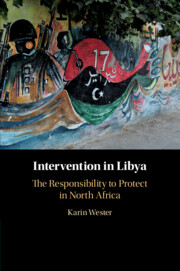Book contents
- Intervention in Libya
- Intervention in Libya
- Copyright page
- Dedication
- Epigraph
- Contents
- Preface
- Maps
- Introduction
- 1 The Origin of the Responsibility to Protect
- 2 Authority Based on Protection in a Historical Context
- 3 Libya and the Era of Qadhafi’s Rule
- 4 The Libyan Uprising and the International Response, February 15–26, 2011
- 5 The Libyan Uprising and the International Response, February 26–March 17, 2011
- 6 Operation Odyssey Dawn
- 7 Operation Unified Protector, NATO, and the UN
- 8 A Divided International Community Confronts a Divided Libya
- 9 Lessons to Be Learned
- Epilogue
- Select Bibliography
- Index
4 - The Libyan Uprising and the International Response, February 15–26, 2011
Published online by Cambridge University Press: 28 February 2020
- Intervention in Libya
- Intervention in Libya
- Copyright page
- Dedication
- Epigraph
- Contents
- Preface
- Maps
- Introduction
- 1 The Origin of the Responsibility to Protect
- 2 Authority Based on Protection in a Historical Context
- 3 Libya and the Era of Qadhafi’s Rule
- 4 The Libyan Uprising and the International Response, February 15–26, 2011
- 5 The Libyan Uprising and the International Response, February 26–March 17, 2011
- 6 Operation Odyssey Dawn
- 7 Operation Unified Protector, NATO, and the UN
- 8 A Divided International Community Confronts a Divided Libya
- 9 Lessons to Be Learned
- Epilogue
- Select Bibliography
- Index
Summary
Chapter 4 and subsequent chapters focus on the events evolving in Libya from February until October 2011, and examine how international actors invoked and applied the responsibility to protect in their response to those events. Chapter 4 focuses on the period from February 15 , the date around which the Libyan uprising began, until February 26, 2011, when the UN Security Council adopted resolution 1970. The study reconstructs how Libyan citizens, emboldened by previous revolts in Tunisia and Egypt, and driven by pent up anger and resentment over years of suppression, took to the streets, and how the Libyan regime responded with excessive violence against the initially unarmed protesters. The protesters were quickly joined by high-level defectors from the Libyan regime, the army and the diplomatic ranks, who took it upon themselves to represent the uprising politically. The international community, notably the UN Security Council, responded to the situation in Libya with unprecedented speed and remarkable unity. On the basis of a reconstruction of the relevant decision-making processes, the study argues that the responsibility to protect clearly framed the response of the international community to the Libyan crisis – which ultimately resulted in the adoption of Security Council resolution 1970.
Keywords
- Type
- Chapter
- Information
- Intervention in LibyaThe Responsibility to Protect in North Africa, pp. 93 - 132Publisher: Cambridge University PressPrint publication year: 2020

